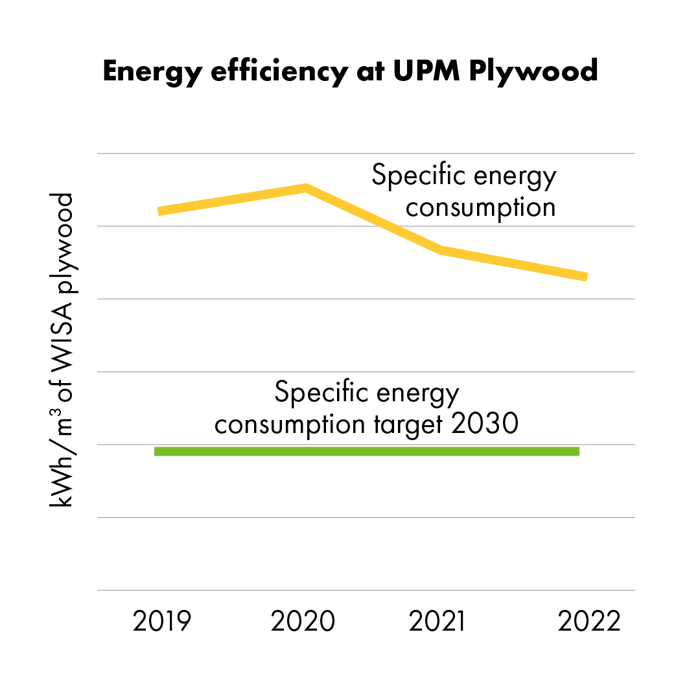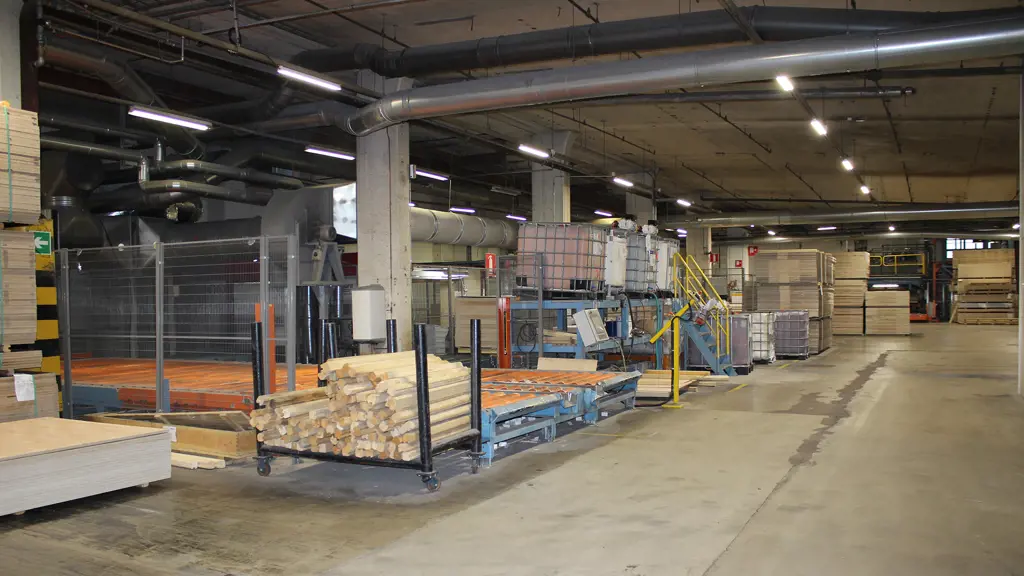Improving production efficiency and reducing emissions is one of UPM Plywood's three climate action areas, along with sustainable forest management and carbon-storing WISA products. UPM is committed to reducing its own CO2 emissions by 65% and CO2 emissions from its supply chain by 30% by 2030.
The production of plywood requires a lot of heat and electricity. According to Sanna Kontinen, Environmental Manager at UPM Plywood, about 80% of the energy used in the company's plywood mills is heat and the rest electricity.
"Almost 100 percent of the heat needed to produce WISA plywood is produced by bioenergy. The by-products of production, such as bark and wood chips, are used as fuel in heating or power plants, which produce the heat and, in some cases, electricity needed in the factory," says Kontinen.
"The electricity required for production is purchased in Finland from UPM Energy, whose electricity production is mainly from climate-sustainable and emission-free hydro and nuclear power. At our Estonian mill, electricity is purchased from local electricity distributors."
The energy efficiency of UPM Plywood's operations has improved significantly over the years through new ideas and innovations. The goal is to further increase the energy efficiency of production by 1% annually by 2030.

The continuous improvement of energy efficiency encourages ideas on concrete ways to achieve this goal.
"The ideas for improvement come largely from the people working in the factories, who know best about the issue at hand. Each of us can make suggestions. If the idea is good and requires some technical investment, it will go forward according to UPM's investment procedure. Once the improvement is implemented, the energy savings achieved are verified through monitoring," Kontinen says.
"Not all energy efficiency measures require investment. Idle machinery and equipment, open doors and leaking compressed air pipes consume energy and produce nothing. These are also things that each of us can influence through our own actions."
Making use of waste heat at UPM Pellos mills
A recent example of an investment in improvement comes from UPM Pellos' mills, where WISA spruce plywood is produced for construction use. The factories' air compressors use electricity to produce compressed air for the factory's compressed air network. At the same time, waste heat is generated that was previously discharged. This changed when energy engineer Teemu Puttonen had the idea to build a heat recovery system.
"When I am touring factories, I often think of different ways to improve energy efficiency. For example, I try to identify waste heat streams that could be used in another site, so that the amount and timing of the waste heat and the energy required by the site match as closely as possible," says Puttonen, explaining the background to the idea.
In a heat recovery system for air compressors, waste heat is recovered in the water circulating in the compressors, stored in a hot water tank and then fed into the plant's domestic hot water or heating network. As the demand for domestic hot water is year-round, the solution makes efficient use of waste heat.
The energy savings achieved by the waste heat recovery system amount to a significant 1,800 MWh per year. The recovered heat is used to heat most of the domestic hot water in the UPM Pellos mill area and part of the heating of the buildings in the area.
"The amount of heat saved could heat about 90 electrically heated private houses all year round In Finnish conditions," Puttonen compares.
LED lighting for energy savings and improved safety at work
UPM Plywood is also currently implementing a lighting upgrade at its Finnish mills. At the mills, the lighting in the production areas and active storage areas and in the case of UPM Pellos, also the outdoor lighting will be replaced with LED lights. LED lights have already been introduced at the Joensuu, Savonlinna, Kalso and Pellos 2 and 3 mills. The next year they will also be introduced at Pellos 1 mill and in outdoor lighting.
LED technology consumes 60-80% less electricity than traditional discharge lamps and fluorescent lamps. The lighting upgrade will reduce CO2 emissions by 565 tonnes per year and save 5,650 MWh of electricity. The amount of energy saved is equivalent to the electricity consumption of more than 280 detached houses in Finland. In addition to energy efficiency, the upgrade will also improve safety at work and make work smoother and more comfortable.

"Even small energy-saving measures - whether it's heating, water use or powering machinery - add up to significant savings and emission reductions. In addition to the environmental benefits, they also improve the cost-effectiveness of operations," Kontinen points out.
"At UPM, we have a plan and concrete targets, and we will continue our work to improve energy efficiency in line with them."
This article is part of our new Plywood Beyond Fossils series. The series presents concrete measures UPM Plywood is taking to help mitigate climate change. Read more on our Responsibility Made Easy website.
Text: Janne Suokas